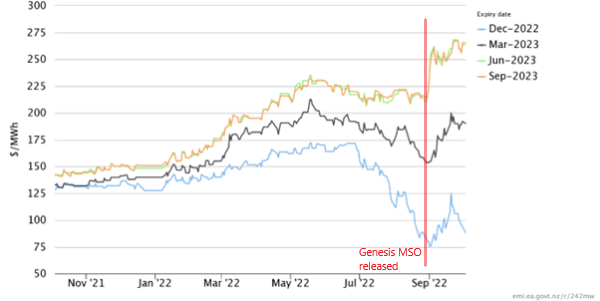Eye on electricity
The forward electricity market explained
Why do we have a forward electricity market? How are forward prices determined? And what influences forward prices?
- Consumers
- Generation
- Wholesale
- Prices

Why do we have a forward electricity market?
Electricity in New Zealand is sold from generators to buyers1 every 30 minutes via auctions. These buyers must pay the electricity spot price, explained in our article on electricity price volatility, which changes every auction to reflect underlying market conditions.
The forward electricity market (or electricity futures), however, allows electricity buyers to purchase a forward contract. This contract protects buyers against volatile spot prices by fixing their electricity price for a specified period. This creates more certainty in the market, as electricity buyers (sellers) will have more stable costs (earnings).
How are forward prices determined?
Forward prices reflect expectations of future electricity demand and generation costs. These prices are determined by market buyers and sellers and therefore represent the consensus view of future prices.
Forward price contracts for New Zealand electricity can span a period of months or quarters. This reflects the extent the contract covers. Contracts ending within a year are dubbed ‘short-dated’ contracts, while those extending over a year are called ‘long-dated’ contracts.
What influences forward prices?
Current and projected market conditions impact forward electricity prices. Hydro storage, as explained in our article on how hydro storage impacts spot prices, tends to heavily impact short-dated future prices, making them potentially more volatile than long-dated future prices. High hydro storage depresses spot prices as abundant hydroelectricity can be offered cheaply into the market. So the cost of short-dated forward prices tends to fall as hydro storage increases.
Figure 1 shows short-dated forward electricity prices as of 3 October 2022. The December 2022 contract price began declining in early July 2022, as hydro storage began increasing (see vertical blue line). This indicates that high hydro storage is likely to keep spot prices depressed through to December 2022. The March 2023 contract price dipped slightly as hydro storage increased, however it has since increased again. The cost of the June and September 2023 quarter contracts did not react to increasing storage, as these were unlikely to be impacted by high hydro storage.
Other factors which can impact forward prices are seasonal climate expectations, namely the possibility of either an El Niño or its sister La Niña. The El Niño-Southern Oscillation can affect the electricity industry at both ends of the spectrum, by changing expected demand patterns and weather systems, which impacts both hydro and wind generation.
Industry participants can also impact forward electricity prices with corporate announcements. For example, in July 2020 when Rio Tinto announced that the Tiwai Point aluminum smelter (which is New Zealand’s largest electricity consumer2) would cease operating, forward prices declined sharply. This reflected an expectation that more electricity would be available in the market after its closure. However, when in January 2021 it was announced that Tiwai Point would remain open, forward prices bounced back up.
In late August 2022, Genesis3 launched their Market Security Option. This indicated an expectation of rising thermal fired electricity generation costs, and subsequently forward prices increased, as seen in Figure 1 (see vertical red line for the announcement date).
The Electricity Authority monitors the forward electricity market and publishes commentary in each quarterly review. Readers can find interactive plots showing how forward electricity prices are changing at: Electricity Authority - EMI (market statistics and tools).
1. Both retailers, who buy electricity on the behalf of consumers, and large industrial electricity users.
2. Consuming roughly 12% of New Zealand’s electricity.
3. A company which operates many New Zealand power stations.
Related News
Better data to unlock better deals for consumers
The Electricity Authority Te Mana Hiko has published a proposal to make better data available to unlock better power deals for consumers.
Register for webinar: Unlocking network connection barriers
Late last year the Electricity Authority Te Mana Hiko consulted on a package of changes to reduce the time and cost to connect infrastructure such as public EV…
New members appointed to the Electricity Authority Advisory Group
We’re pleased to announce the appointment of 10 new members to the Electricity Authority Advisory Group, following our recent call for nominations.